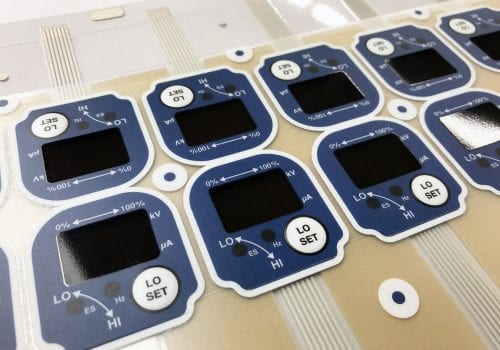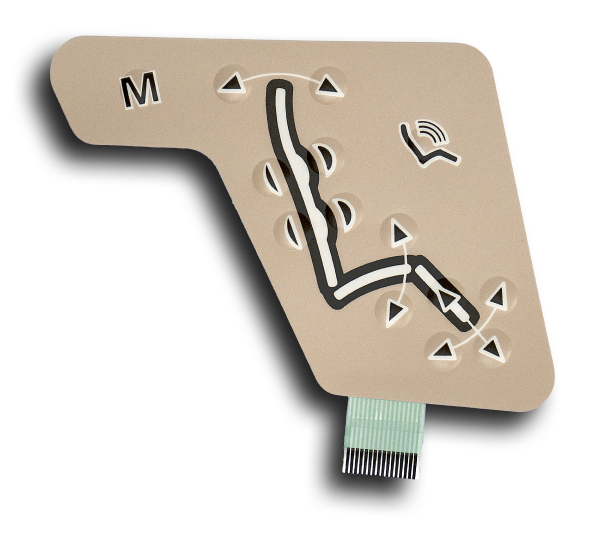All About Membrane layer Switch: A Comprehensive Guide for Beginners
Membrane switches are important parts in modern electronics, providing a special user interface for user interaction - membrane switch. Their layered construction, consisting of overlays and conductive traces, provides capability and toughness. Unlike traditional mechanical buttons, membrane buttons offer a smooth design and customizable alternatives. Recognizing their key attributes and benefits can change item layout. Nonetheless, the details of their application and design considerations warrant more expedition
What Is a Membrane layer Change?
A membrane layer switch is a sort of electric button that consists of an adaptable membrane layered over a published circuit board. This layout permits a compact and smooth interface, typically used in different digital gadgets. Membrane buttons are frequently found in consumer appliances, clinical tools, and industrial equipment due to their sturdiness and resistance to environmental factors.The construction usually consists of several layers, such as visuals overlays and sticky support, which provide tactile comments and protect the circuitry underneath. The procedure of a membrane layer button is launched when stress is used to the surface, finishing an electrical circuit.These buttons are valued for their convenience, making it possible for custom styles and printed graphics that accommodate details interface. Their low-profile nature minimizes space requirements, making them perfect for applications where standard switches might not fit. In general, membrane switches offer a practical and aesthetic remedy for modern digital tools.
Secret Elements of Membrane Layer Switches
Membrane changes comprise numerous vital components that contribute to their capability and efficiency. The leading layer, referred to as the overlay, supplies the customer interface and is frequently published with icons or graphics. Under the overlay exists a spacer layer, which divides the conductive components and protects against unintended activation. The following essential component is the graphic layer, which enhances aesthetics and guarantees the resilience of the design.Conductive traces, generally made from materials like silver or carbon, are printed on the circuit layer. When pressure is applied to the overlay, these traces enter call, finishing the circuit. In addition, a support layer provides architectural assistance and can be made from products such as polyester or polycarbonate. Together, these elements produce a trustworthy, easy to use user interface ideal for numerous applications, from home home appliances to commercial tools. Comprehending these elements is essential for any individual curious about membrane button technology.
Just How Membrane Switches Work
Recognizing how membrane changes feature is important for appreciating their widespread use in different gadgets. A membrane layer switch operates with a collection of layers, consisting of a graphic overlay, spacer, and a circuit layer. When pressure is used to the overlay, it presses the spacer layer, permitting the circuit layer to make get in touch with and finish an electric circuit. This action sends out a signal to the device, triggering a response, such as switching on a light or triggering a function.Membrane changes can be developed with various attributes, consisting of tactile comments, backlighting, and custom graphics, enhancing customer communication. Their building and construction permits for a covered style, securing the internal elements from dirt, moisture, and contaminants. This resilience makes them appropriate for diverse applications, from consumer electronics to industrial devices. Overall, the simplicity and performance of membrane layer changes contribute to their popularity in modern-day technology.
Benefits of Membrane Layer Switches Mechanical Buttons
While mechanical buttons have actually long been a staple in many devices, membrane changes deal distinct advantages that make them progressively appealing. One considerable advantage is their slim profile, permitting even more portable designs and greater adaptability in product growth. In addition, membrane layer changes function an uniform surface, which enhances visual allure and simplifies cleansing, making them suitable for atmospheres where hygiene is critical.Another advantage is their resistance to dirt and moisture. Unlike mechanical buttons, which can be endangered by environmental elements, membrane layer buttons offer a sealed interface that shields versus contaminants - membrane switch. In addition, membrane switches typically have a longer lifespan because of fewer relocating parts, causing boosted longevity and reliability.Cost-effectiveness is additionally a significant benefit, as membrane layer switches can be generated wholesale with lower production expenses. These aspects combine to position membrane buttons as a functional option to typical mechanical options in numerous applications
Usual Applications of Membrane Switches Over
Membrane layer switches are commonly made use of in different industries, specifically in consumer electronics and industrial control board. In customer tools, they give a streamlined, straightforward interface, while in commercial setups, they boost toughness and capability. Understanding these applications highlights the convenience and practicality of membrane switches in contemporary innovation.
Customer Electronic Devices Instruments
As customer electronic devices remain to develop, membrane layer switches have come to be a preferred choice for a selection of gadgets because of their versatility and smooth design. These switches are typically found in mobile phones, tablet computers, and push-button controls, where space is limited and visual appeals issue. Their reduced profile and personalized designs allow manufacturers to create user-friendly interfaces that improve the general user experience. In addition, membrane layer buttons are often utilized in home appliances such as microwaves and coffee makers, giving user-friendly control alternatives while resisting moisture and dust. The resilience and reliability of membrane changes make them appropriate for day-to-day customer products, making sure longevity and constant efficiency. Overall, their combination in consumer electronic devices shows a blend of functionality and contemporary style.
Industrial Control Panels
The applications of membrane switches prolong beyond customer electronic devices, discovering considerable use in commercial control board. These switches are favored for their longevity and resistance to harsh environments, making them optimal for producing and procedure control settings. They give a trusted interface for operators to control equipment, monitor procedures, and adjust setups. Membrane layer switches can be customized to suit particular functional needs, including attributes like backlighting and tactile responses, enhancing individual experience. Their low-profile layout permits combination into numerous equipment, while their ability to withstand spills, dirt, and extreme temperature levels assurances durability. In general, membrane layer switches contribute to safe and efficient procedure in commercial applications, demonstrating their adaptability and effectiveness sought after environments.
Factors To Consider for Designing Membrane Layer Switches
When creating membrane layer switches, choosing the ideal products is important to ensure durability and functionality. In addition, comprehending layer arrangement strategies can considerably affect the switch's efficiency and customer experience. These factors to consider play an essential function in developing reputable and efficient membrane button styles.
Product Selection Value
Material option plays an important duty in the layout and functionality of membrane switches. The picked materials straight impact the switch's durability, tactile feedback, and overall visual. Secret factors to consider consist of the substrate, which need to supply structural integrity while enabling adaptability, and the graphic overlay, which needs to be resistant to use and environmental factors. Conductive materials ought to ensure reliable electric performance, while adhesives must offer strong bonding without endangering the button's procedure. In addition, compatibility with manufacturing processes and end-user atmospheres is important; materials need to hold up against differing temperature levels, humidity degrees, and chemical direct exposure. Ultimately, appropriate product option not just enhances the membrane button's performance however also adds to try these out its longevity and customer fulfillment, making it a vital element of the design procedure.

Layer Arrangement Strategies

Regularly Asked Questions
The Length Of Time Do Membrane Layer Switches Typically Last?
Membrane buttons typically have a life-span of 1 to 5 million cycles, relying on usage and environmental conditions. Factors such as design top quality and operating frequency greatly affect their toughness and total efficiency longevity.

Can Membrane Changes Be Customized for Details Layouts?
Membrane layer switches can certainly be tailored to fit details layouts, permitting for diverse forms, shades, and capabilities. This flexibility makes it possible for suppliers to tailor these switches to fulfill unique visual and operational demands efficiently.
What Materials Are Made Use Of in Membrane Switch Building And Construction?
Membrane buttons are usually created making use of materials such as polyester, polycarbonate, and adhesive layers. These products give resistance, flexibility, and sturdiness to ecological variables, guaranteeing the switches function efficiently in different applications and problems.
Are Membrane Switches Over Water-proof or Resistant to Moisture?
Membrane buttons can be designed to be moisture-resistant, using specialized products and coverings. However, their waterproof capabilities rely on building top quality and certain applications, making it necessary to examine requirements for ideal performance in different environments.
Just How Are Membrane Switches Over Repaired if Damaged?
Fixing broken membrane changes usually entails replacing the influenced layer or circuit. Professionals might likewise apply conductive glue or use specialized repair kits, making certain functionality is recovered without full substitute of the entire button assembly. Unlike standard mechanical switches, membrane switches offer a smooth design and adjustable choices. A membrane layer switch is a type of electric button that consists of a flexible membrane layered over a printed circuit board. The operation of a membrane button is initiated when stress is applied to the surface, completing an electrical circuit.These buttons are valued for their flexibility, enabling custom-made layouts and printed graphics that provide to particular individual interfaces. While mechanical buttons have long been a staple in many devices, membrane switches deal unique benefits that make them progressively appealing. Membrane buttons commonly have a useful source longer lifespan due to less moving parts, resulting in enhanced sturdiness and reliability.Cost-effectiveness is additionally a significant benefit, as membrane switches can be produced in mass with reduced production expenses.